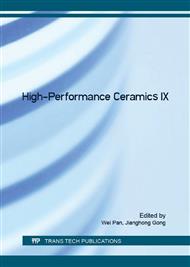p.539
p.547
p.551
p.555
p.561
p.565
p.572
p.576
p.581
Preparation of Glass-Ceramics by Reactive Crystallization with Waste Glass and Mullite
Abstract:
Diopside glass-ceramics were prepared by reactive crystallization with mixed powder of waste glass and mullite. The effects of mullite content and sintering temperature and holding time on the crystal phase and morphology of diopside glass-ceramics were investigated. The reactive crystallizing behavior between waste glass powder and mullite was studied using energy dispersive spectrdmeter during the sintering and holding process. The result show that the optimum preparation conditions were as follows: the addition of 30 wt% mullite used as crystallization promoting agent, sintering temperature of 900 °C and holding time of 2h. The main difference between reactive crystallization method and the traditional method of preparing diopside glass-ceramics was the reactive crystallization mechanism. The diopside and corundum crystals were formed via an interaction between glass powder and mullite instead of direct precipitation from the parent glass during the calcining and holding process. With the increasing of sintering temperature and holding time, the Ca and Mg element concents of the glass were increased, on the contrary, that Si element concent was decreased in the mullite. It shows that the Si element diffused from mullite to glass and precipitated diopside crystals.
Info:
Periodical:
Pages:
561-564
Citation:
Online since:
July 2016
Authors:
Keywords:
Price:
Сopyright:
© 2016 Trans Tech Publications Ltd. All Rights Reserved
Share:
Citation:


